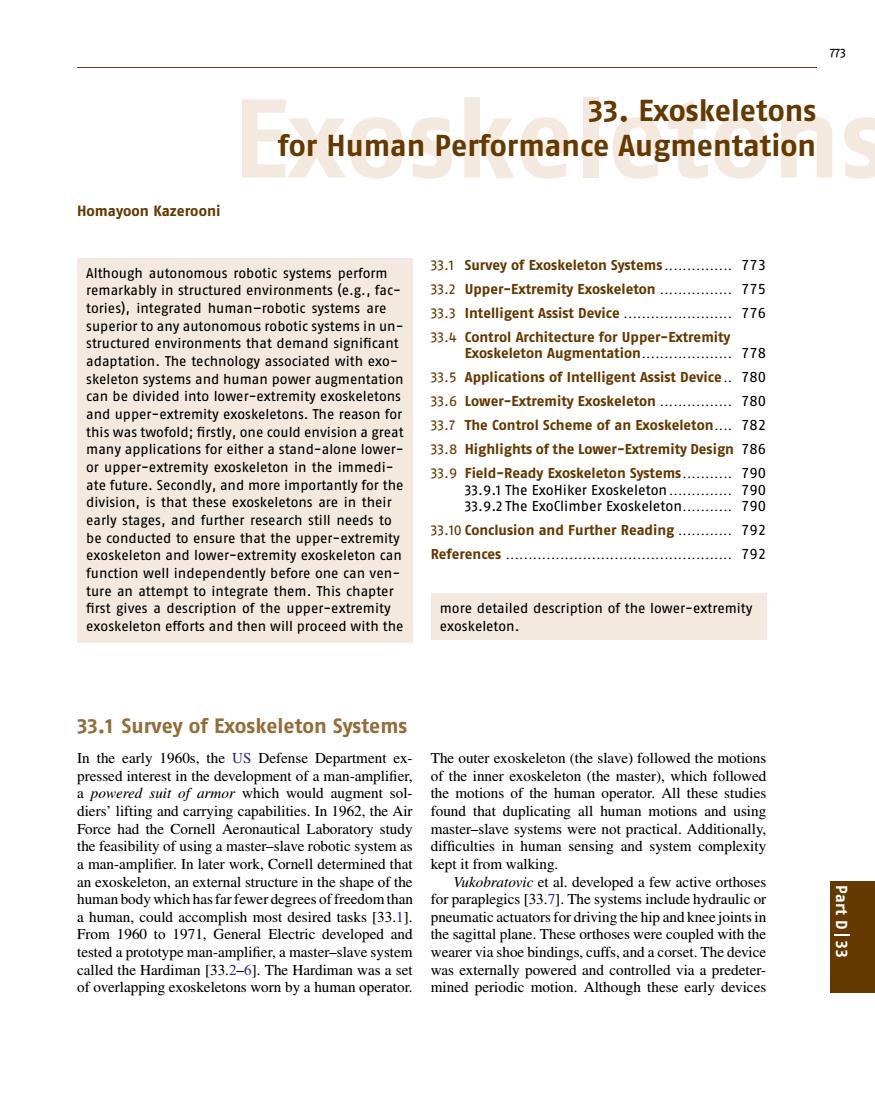正在加载图片...

773 33.Exoskeletons for Human Performance Augmentation Homayoon Kazerooni Although autonomous robotic systems perform 33.1 Survey of Exoskeleton Systems.............. 773 remarkably in structured environments(e.g.,fac- 33.2 Upper-Extremity Exoskeleton................775 tories),integrated human-robotic systems are 33.3 Intelligent Assist Device....................... 776 superior to any autonomous robotic systems in un- structured environments that demand significant 33.4 Control Architecture for Upper-Extremity 778 adaptation.The technology associated with exo- Exoskeleton Augmentation................. skeleton systems and human power augmentation 33.5 Applications of Intelligent Assist Device..780 can be divided into lower-extremity exoskeletons 33.6 Lower-Extremity Exoskeleton 780 and upper-extremity exoskeletons.The reason for this was twofold;firstly,one could envision a great 33.7 The Control Scheme of an Exoskeleton....782 many applications for either a stand-alone lower- 33.8 Highlights of the Lower-Extremity Design 786 or upper-extremity exoskeleton in the immedi- 33.9 Field-Ready Exoskeleton Systems...........790 ate future.Secondly,and more importantly for the 33.9.1 The ExoHiker Exoskeleton............. 790 division,is that these exoskeletons are in their 33.9.2 The ExoClimber Exoskeleton........... 790 early stages,and further research still needs to be conducted to ensure that the upper-extremity 33.10 Conclusion and Further Reading 792 exoskeleton and lower-extremity exoskeleton can References.… 792 function well independently before one can ven- ture an attempt to integrate them.This chapter first gives a description of the upper-extremity more detailed description of the lower-extremity exoskeleton efforts and then will proceed with the exoskeleton. 33.1 Survey of Exoskeleton Systems In the early 1960s,the US Defense Department ex- The outer exoskeleton (the slave)followed the motions pressed interest in the development of a man-amplifier,of the inner exoskeleton (the master),which followed a powered suit of armor which would augment sol- the motions of the human operator.All these studies diers'lifting and carrying capabilities.In 1962,the Air found that duplicating all human motions and using Force had the Cornell Aeronautical Laboratory study master-slave systems were not practical.Additionally. the feasibility of using a master-slave robotic system as difficulties in human sensing and system complexity a man-amplifier.In later work,Cornell determined that kept it from walking. an exoskeleton,an external structure in the shape of the Vukobratovic et al.developed a few active orthoses human body which has far fewer degrees of freedom than for paraplegics [33.7].The systems include hydraulic or a human,could accomplish most desired tasks [33.1].pneumatic actuators for driving the hip and knee joints in Part From 1960 to 1971,General Electric developed and the sagittal plane.These orthoses were coupled with the tested a prototype man-amplifier,a master-slave system wearer via shoe bindings,cuffs,and a corset.The device called the Hardiman [33.2-6].The Hardiman was a set was externally powered and controlled via a predeter- of overlapping exoskeletons worn by a human operator. mined periodic motion.Although these early devices773 Exoskeletons 33. Exoskeletons for Human Performance Augmentation Homayoon Kazerooni Although autonomous robotic systems perform remarkably in structured environments (e.g., factories), integrated human–robotic systems are superior to any autonomous robotic systems in unstructured environments that demand significant adaptation. The technology associated with exoskeleton systems and human power augmentation can be divided into lower-extremity exoskeletons and upper-extremity exoskeletons. The reason for this was twofold; firstly, one could envision a great many applications for either a stand-alone loweror upper-extremity exoskeleton in the immediate future. Secondly, and more importantly for the division, is that these exoskeletons are in their early stages, and further research still needs to be conducted to ensure that the upper-extremity exoskeleton and lower-extremity exoskeleton can function well independently before one can venture an attempt to integrate them. This chapter first gives a description of the upper-extremity exoskeleton efforts and then will proceed with the 33.1 Survey of Exoskeleton Systems ............... 773 33.2 Upper-Extremity Exoskeleton ................ 775 33.3 Intelligent Assist Device ........................ 776 33.4 Control Architecture for Upper-Extremity Exoskeleton Augmentation.................... 778 33.5 Applications of Intelligent Assist Device .. 780 33.6 Lower-Extremity Exoskeleton ................ 780 33.7 The Control Scheme of an Exoskeleton.... 782 33.8 Highlights of the Lower-Extremity Design 786 33.9 Field-Ready Exoskeleton Systems ........... 790 33.9.1 The ExoHiker Exoskeleton.............. 790 33.9.2 The ExoClimber Exoskeleton........... 790 33.10 Conclusion and Further Reading ............ 792 References .................................................. 792 more detailed description of the lower-extremity exoskeleton. 33.1 Survey of Exoskeleton Systems In the early 1960s, the US Defense Department expressed interest in the development of a man-amplifier, a powered suit of armor which would augment soldiers’ lifting and carrying capabilities. In 1962, the Air Force had the Cornell Aeronautical Laboratory study the feasibility of using a master–slave robotic system as a man-amplifier. In later work, Cornell determined that an exoskeleton, an external structure in the shape of the human body which has far fewer degrees of freedom than a human, could accomplish most desired tasks [33.1]. From 1960 to 1971, General Electric developed and tested a prototype man-amplifier, a master–slave system called the Hardiman [33.2–6]. The Hardiman was a set of overlapping exoskeletons worn by a human operator. The outer exoskeleton (the slave) followed the motions of the inner exoskeleton (the master), which followed the motions of the human operator. All these studies found that duplicating all human motions and using master–slave systems were not practical. Additionally, difficulties in human sensing and system complexity kept it from walking. Vukobratovic et al. developed a few active orthoses for paraplegics [33.7]. The systems include hydraulic or pneumatic actuators for driving the hip and knee joints in the sagittal plane. These orthoses were coupled with the wearer via shoe bindings, cuffs, and a corset. The device was externally powered and controlled via a predetermined periodic motion. Although these early devices Part D 33